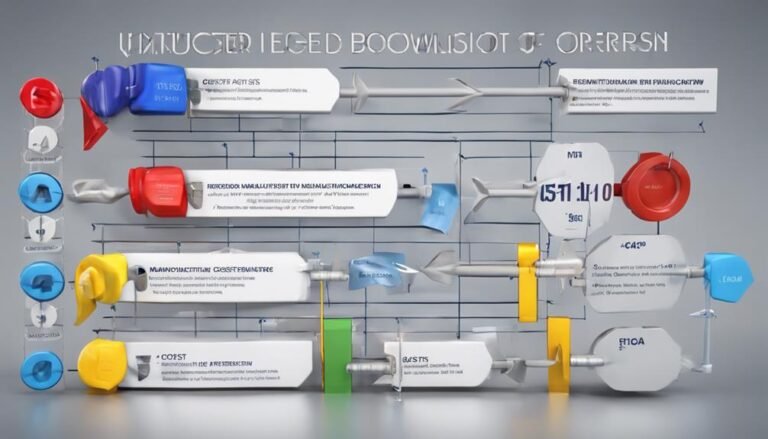What Is a Bridge Loan and How Does It Work, With Example
A bridge loan acts as a short-term financial tool bridging immediate funding needs and long-term financing, offering quick access to capital but often with higher interest rates. It requires managing payments on multiple loans simultaneously. For instance, Olayan America Corp utilized a bridge loan from ING Capital for the Sony Building acquisition, illustrating its practical application in real estate. While providing immediate cash flow, bridge loans necessitate evaluating pros and cons due to higher interest rates compared to traditional financing. Consider the benefits and risks carefully to make well-informed financial decisions. Additional insights into bridge loans and their mechanics are available.
Key Takeaways
- Bridge loans bridge short-term financial gaps.
- They offer quick access to funds.
- Example: Olayan America Corp used bridge loan for Sony Building acquisition.
- Process involves application, underwriting, approval, and funding.
- Benefits include fast processing, customizable options, and no repayment penalties.
Definition and Purpose of Bridge Loans
Unlike a home loan, which is a long-term mortgage used to finance the purchase of a home, a bridge loan provides temporary funding until permanent financing is secured or the existing property is sold.
A bridge loan serves as a short-term financial tool designed to assist individuals and businesses in bridging the gap between the need for immediate funds and the availability of long-term financing. Bridge loan benefits include providing short-term cash flow, aiding in purchasing a new home before selling the current one, and offering quick access to funds.
However, drawbacks of bridge loans include higher interest rates compared to traditional loans and the requirement to make payments on multiple loans simultaneously. Eligibility criteria for bridge loans typically involve having a solid exit strategy for repaying the loan, providing collateral, and demonstrating the ability to cover the loan costs.
Prospective borrowers should carefully evaluate the benefits and drawbacks of bridge loans before opting for this financing option.
Mechanics of Bridge Loan Process
The mechanics of the bridge loan process involve a series of structured steps that facilitate the efficient and timely provision of short-term financing to borrowers.
- Application Process
Borrower submits application with financial details and collateral information.
- Underwriting and Approval
Lender evaluates borrower’s financial situation and the collateral’s value.
- Approval Timeline
Approval timeline varies but is generally quicker than traditional loans.
- Funding Process
Once approved, funds are disbursed to the borrower promptly for their use.
These steps guarantee that bridge loans can be processed swiftly, providing borrowers with the necessary short-term financial support.
Real-Life Bridge Loan Example
Illustrating the practical application of bridge loans in the real estate industry, a notable example showcases how Olayan America Corp. utilized a bridge loan from ING Capital for the acquisition of the Sony Building in NYC. This strategic move in the NYC real estate market dynamics allowed Olayan America Corp. to quickly secure the necessary funds to purchase the prestigious Sony Building.
Bridge Loans Vs. Conventional Financing
In comparison to conventional financing options, bridge loans offer distinct advantages and considerations for individuals and companies seeking short-term financial solutions.
- Bridge Loan Advantages:
- Quick application, approval, and funding processes
- Customizable for various situations by lenders
- Ideal for those needing immediate but short-term financing
- No repayment penalties in most cases
When comparing bridge loans to traditional financing, it is essential to weigh the benefits of quick access to funds against the risks of higher interest rates and potential for increased financial burden due to payments on multiple loans. Understanding these advantages and risks is vital in determining the suitability of bridge loans for specific financial needs.
Evaluating Pros and Cons of Bridge Loans
Evaluating the benefits and drawbacks of bridge loans is essential in determining their suitability for short-term financial needs. When weighing options, borrowers must consider the higher interest rates associated with bridge loans compared to traditional financing. While bridge loans provide immediate cash flow and can be useful for purchasing a new home before selling the current one, they require payments on multiple loans simultaneously.
These financial considerations highlight the trade-offs that come with bridge loans. Borrowers should carefully assess their financial situation and short-term needs to decide if the convenience of a bridge loan outweighs the associated costs. Understanding the pros and cons of bridge loans is vital for making well-informed financial decisions.
Conclusion
To sum up, bridge loans offer a temporary financial solution for individuals and companies in need of immediate cash flow.
Like a lifeline in turbulent waters, bridge loans bridge the gap between financial needs and available funds, providing a valuable tool for securing real estate acquisitions and meeting short-term obligations.
Despite their advantages, borrowers must carefully evaluate the pros and cons of bridge loans to make informed financial decisions.







